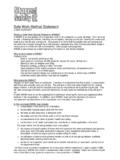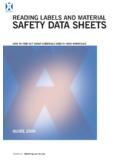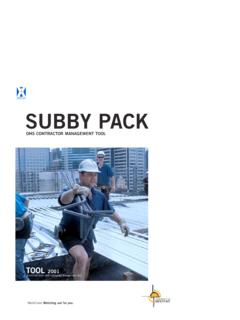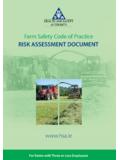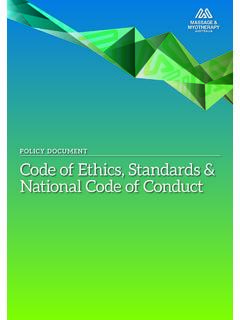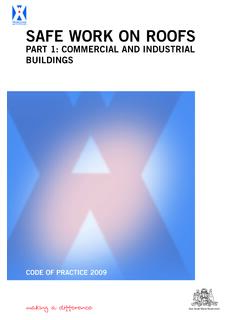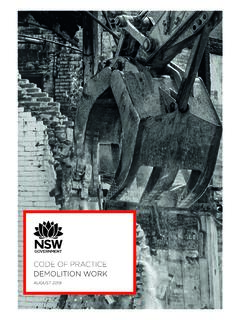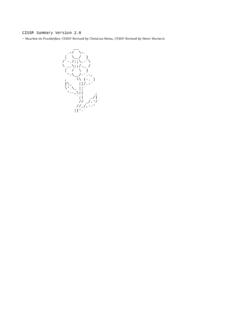Transcription of Code of practice: Risk Assessment - Stage Safety
1 Risk 02/07/02 1:11 PM Page 2. RISK. Assessment . code OF PRACTICE. WorkCover NSW Health and Safety code of Practice 2001. WorkCover. Watching out for you. Risk 02/07/02 1:11 PM Page 3. Disclaimer This is a code of Practice which contains industry recommended action for managing workplace Safety . It includes some of your obligations under the various Workers Compensation and Occupational Health and Safety Legislation that WorkCover administers. To ensure you comply with your legal obligations you must refer to the appropriate acts. Foreword The Special Minister of State has approved this industry code of Practice on the recommendation of WorkCover NSW to provide practical guidance for employers to meet their obligations to assess health and Safety risks in the workplace.
2 General Manager WorkCover NSW. 1. Introduction What is an INDUSTRY code OF PRACTICE ? An approved industry code of practice is a practical guide to achieving the standard of Safety required by the Occupational Health and Safety Act 2000 and OHS Regulation 2001 for a particular area of work. This approved industry code of practice should be followed unless there is an alternative course of action, which achieves the same or better standard of health and Safety in the workplace. An industry code of practice is approved by the Special Minister for State. It comes into effect on the day the notice of this approval is published in the NSW Government Gazette or on the day specified in the Gazette notice. An approved industry code of practice is designed to be used in conjunction with the Act and Regulation but does not have the same legal force.
3 A person or company cannot be prosecuted for failing to comply with an approved industry code of practice. However, in proceedings under the Act or Regulation, failure to observe a relevant approved industry code of practice can be used as evidence that a person or company has contravened or failed to comply with the provisions of the Act or Regulation. A WorkCover Inspector may cite an approved industry code of practice in a direction or in an improvement or prohibition notice, indicating the measures that should be taken to remedy an alleged contravention or non-compliance. Failure to comply with a requirement in an improvement or prohibition notice is an offence. In summary an approved INDUSTRY code OF PRACTICE. gives practical guidance on how the required standard of health, Safety and welfare can be achieved in an area of work.
4 Should be followed, unless there is an alternative course of action which achieves the same or better standard of health and Safety in the workplace;. can be used in support of the preventative enforcement provisions of the Occupational Health and Safety Act;. can be used to support prosecutions for failing to comply with or contravening the Act or Regulation. 1. Title This is the code of Practice for Risk Assessment . Scope This industry code of Practice applies to all workplaces where an employer has an obligation to carry out a risk Assessment of identified hazards apart from mines within the meaning of the Coal Mines Regulation Act 1982 or the Mines Inspection Act 1901. A note in this document does not form part of the code of Practice.
5 Commencement This industry code of Practice commences on the date it is published in the NSW Government Gazette. [This code of Practice was published in the NSW Government Gazette on 21 September 2001]. Authority This is an industry code of practice approved by the Special Minister of State under Section 43 of the Occupational Health and Safety Act 2000. 2. Risk Employers have obligations under the Occupational Health and Safety Regulation 2001 to identify any foreseeable hazards that may arise in Management the workplace and to assess the risk of harm arising from the identified hazards. Employers then have an obligation to eliminate the hazards. If this is not reasonably practicable they must control the risks by implementing measures to lessen the risk of harm to the lowest possible level.
6 The purpose of this code of Practice is to provide practical guidance to assist employers to meet their risk Assessment obligations under the Occupational Health and Safety Regulation 2001. Risk Once a hazard has been identified, an employer must Assessment assess the risk. This should include the following: (i) identify factors that may be contributing to the risk, (ii) review health and Safety information that is reasonably available from an authoritative source and is relevant to the particular hazard, (iii) evaluate the likelihood of an injury occurring and the likely severity of an injury or illness that may occur, (iv) identify the actions necessary to eliminate or control the risk; and (v) identify records that it is necessary to keep to ensure that risks are eliminated or controlled.
7 Note. Section 15(a) of the OHS Act 2000 requires that consultation with employees be undertaken when risks to health and Safety arising from work are assessed. Such consultation should be undertaken with those employees who are directly involved in undertaking the task, or working with the hazardous substance or plant, to which the risk Assessment relates. The employer should adopt a systematic approach to risk Assessment that includes: reviewing any available information about the hazard;. considering factors that contribute to the risk; and deciding what records need to be kept. 2. Factors When assessing risks employers should also identify the factors that may be contributing to the risk, including: contributing to the work premises and the working environment, including their the risk (i).
8 Layout and condition, (ii) the capability, skill, experience and age of people ordinarily undertaking work, (iii) the systems of work being used, and (iv) the range of reasonably foreseeable conditions. Relevant When assessing a particular hazard an employer should health and Safety review reasonably available health and Safety information from an authoritative source and relevant to the particular information hazard, including the following: Note. An authoritative source' refers to such things as: information prepared by the supplier (eg. material Safety data sheets prepared by the supplier of a hazardous substance). information such as Safety Alerts or Fact Sheets prepared by WorkCover industry Codes of Practice Australian Standards documents published by the National Occupational Health and Safety Commission assessments prepared by NICNAS (National Industrial Chemicals Notification and Assessment Scheme).
9 Technical reports prepared by a competent person for a particular workplace. (i) any health and Safety information provided by the supplier of any plant or substance (including a person who hires or leases out plant), (ii) the Material Safety Data Sheet (see OHS Regulation clause 150). for any hazardous substance, (iii) the label of any unopened consumer package containing a hazardous substance, (iv) the register of installed asbestos (created by the controller of the workplace) for any workplace with installed asbestos, (v) results of any biological monitoring carried out for employees of the employer, (vi) results of any atmospheric monitoring of atmospheric contaminants at the workplace, and (vii) information about previous injuries, illness and dangerous incidents.
10 3. Assessment An employer must identify the actions necessary to eliminate the risk, taking into account: to identify risk (i) the factors identified as contributing to the risk, and control options (ii) any specific risk control measures required by the Occupational Health and Safety Regulation 2001. Note. The Occupational Health and Safety Regulation 2001 specifies a number of risk control measures for particular hazards. When a hazard has been identified and the risks are obvious the employer should undertake any research into the hazards necessary to assess the risks . Part of the risk Assessment process involves identifying what you need to do to eliminate or minimize the risk and deciding which control option is appropriate given the degree of risk.

